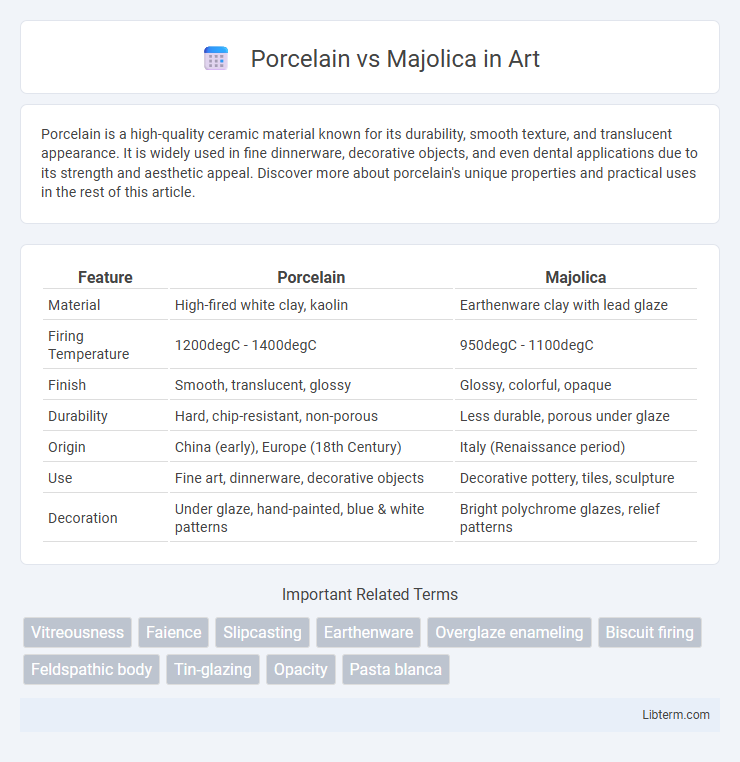Porcelain is a high-quality ceramic material known for its durability, smooth texture, and translucent appearance. It is widely used in fine dinnerware, decorative objects, and even dental applications due to its strength and aesthetic appeal. Discover more about porcelain's unique properties and practical uses in the rest of this article.
Table of Comparison
| Feature | Porcelain | Majolica |
|---|---|---|
| Material | High-fired white clay, kaolin | Earthenware clay with lead glaze |
| Firing Temperature | 1200degC - 1400degC | 950degC - 1100degC |
| Finish | Smooth, translucent, glossy | Glossy, colorful, opaque |
| Durability | Hard, chip-resistant, non-porous | Less durable, porous under glaze |
| Origin | China (early), Europe (18th Century) | Italy (Renaissance period) |
| Use | Fine art, dinnerware, decorative objects | Decorative pottery, tiles, sculpture |
| Decoration | Under glaze, hand-painted, blue & white patterns | Bright polychrome glazes, relief patterns |
Introduction to Porcelain and Majolica
Porcelain is a high-fired ceramic known for its durability, translucency, and smooth, glass-like surface, primarily composed of kaolin clay and fired at temperatures around 1,200 to 1,400degC. Majolica, on the other hand, refers to tin-glazed earthenware that features bright, colorful designs painted on a white opaque glaze, fired at lower temperatures near 1,000degC. The key distinction lies in their composition and firing temperatures, with porcelain prized for strength and elegance and majolica celebrated for vibrant decorative art.
Historical Background of Porcelain
Porcelain originated in China during the Tang Dynasty (618-907 AD) and reached its peak refinement during the Ming Dynasty (1368-1644 AD), becoming a symbol of luxury and artistic craftsmanship worldwide. Early European attempts to replicate porcelain led to the development of distinct ceramic types like majolica, which emerged during the Renaissance with vibrant tin-glazed surfaces influenced by Islamic art. Porcelain's unique composition, combining kaolin clay and high firing temperatures, allowed for its durable, translucent quality, distinguishing it from the more opaque and decorative majolica ceramics.
The Origins and Evolution of Majolica
Majolica originated during the Italian Renaissance in the 15th century, evolving from Islamic pottery techniques introduced through Mediterranean trade routes. Its distinctive tin-glazed earthenware was developed to imitate the brilliance of Chinese porcelain, characterized by vibrant colored glazes and intricate painted designs. Over time, majolica's popularity spread across Europe, influencing decorative arts and leading to regional variations such as the Victorian majolica in England during the 19th century.
Key Characteristics of Porcelain
Porcelain is a high-fired, vitrified ceramic known for its strength, translucency, and smooth white surface, making it ideal for fine tableware and decorative objects. It is composed primarily of kaolin clay combined with feldspar and quartz, which contributes to its durability and resistance to chipping. Unlike Majolica, which is characterized by its opaque tin-glaze and vibrant colors, porcelain typically features a clean, glossy surface achieved through a transparent glaze.
Unique Features of Majolica
Majolica stands out for its vibrant, tin-glazed surface that showcases bright, opaque colors which create a glossy, decorative finish unmatched by porcelain's typically translucent and delicate appearance. The earthenware base of majolica allows for intricate, raised relief designs that enhance its textural richness, contrasting with porcelain's smooth and refined form. Its historical roots in Mediterranean craftsmanship contribute to distinctive hand-painted motifs and a rustic aesthetic that emphasize artistic expression over porcelain's more uniform and refined style.
Differences in Production Techniques
Porcelain is made from fine kaolin clay and fired at extremely high temperatures, typically between 1,200degC to 1,400degC, resulting in a dense, vitrified, and translucent body. Majolica, on the other hand, is created using earthenware clay fired at lower temperatures around 1,000degC, then coated with a tin-based white opaque glaze that allows vibrant, colorful overglaze decoration. The key production difference lies in porcelain's high-temperature vitrification for strength and translucency versus Majolica's low-fired opaque glaze designed for decorative painting on a porous body.
Visual and Aesthetic Comparisons
Porcelain boasts a smooth, translucent surface with a glossy, often white finish that highlights intricate painted designs and fine details. Majolica features vibrant, colorful glazes with a characteristic earthy texture and raised relief patterns, creating a more rustic and lively aesthetic. The visual contrast lies in porcelain's delicate, refined elegance versus majolica's bold, textured vibrancy.
Functional Uses: Porcelain vs Majolica
Porcelain is highly valued for its durability, non-porous surface, and resistance to thermal shock, making it ideal for everyday dinnerware and fine china that withstands frequent use and dishwasher cleaning. Majolica, characterized by its porous earthenware body and tin-glazed surface, excels in decorative tableware and ornamental pieces but is less suited for heavy-duty functional use due to its fragility and susceptibility to chipping. While porcelain offers superior practicality for both domestic and commercial kitchen applications, majolica is preferred for artistic presentation and occasional serving where aesthetic appeal is prioritized.
Durability and Maintenance Considerations
Porcelain is highly durable, known for its hardness, resistance to scratches, and low porosity, making it easy to clean and maintain. Majolica, with its tin-glazed earthenware surface, is more prone to chipping and staining due to its porous nature and delicate glaze. Proper care for majolica involves gentle cleaning and avoiding exposure to harsh chemicals, while porcelain can withstand frequent use and rigorous cleaning without significant wear.
Choosing Between Porcelain and Majolica
Choosing between porcelain and majolica depends on durability, aesthetic preferences, and usage context. Porcelain offers a dense, non-porous surface ideal for everyday use and chip resistance, while majolica showcases vibrant, hand-painted designs with a more porous and delicate structure suited for decorative purposes. Consider porcelain for functional dinnerware and majolica for artistic display or occasional use to balance practicality with ornamentation.
Porcelain Infographic

 libterm.com
libterm.com